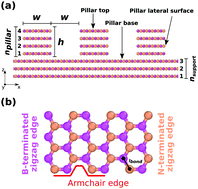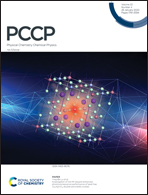Wettability of nanostructured hexagonal boron nitride surfaces: molecular dynamics insights on the effect of wetting anisotropy
Abstract
Nanostructured van der Waals (vdW) layered materials hold great potential for achieving smart surfaces with controllable wettability. Inspired by this possibility, we conduct Molecular Dynamics (MD) simulations of the wetting of nanostructured hexagonal boron nitride (hBN) surfaces. The nanostructure consists of periodically placed nanopillars made of hBN nanoribbons. We demonstrate that the polarity effect of the nanoribbon edges triggers wetting anisotropy of the nanoribbons: the vertical edges of the nanoribbons demonstrate a different wetting behavior as compared to the flat surfaces of the nanoribbons. Depending on the nature of the edge of the nanoribbon (armchair or zigzag), these vertical edges can be more hydrophilic for the zigzag edges or more hydrophobic for the armchair edges than the flat part. Such differences ensure that the nanostructured hBN surfaces become more hydrophilic (hydrophobic) as compared to the flat non-nanostructured hBN surfaces for cases where the edges of the nanoribbon are more hydrophilic (hydrophobic) than the flat part. Overall, the present study develops a most remarkable design space where by introducing nanopillars/nanoribbons on hBN and by merely changing the nature of the edges of these nanopillars, one can ensure atomistically thin coating of hBN with a wide range of wettability.



 Please wait while we load your content...
Please wait while we load your content...